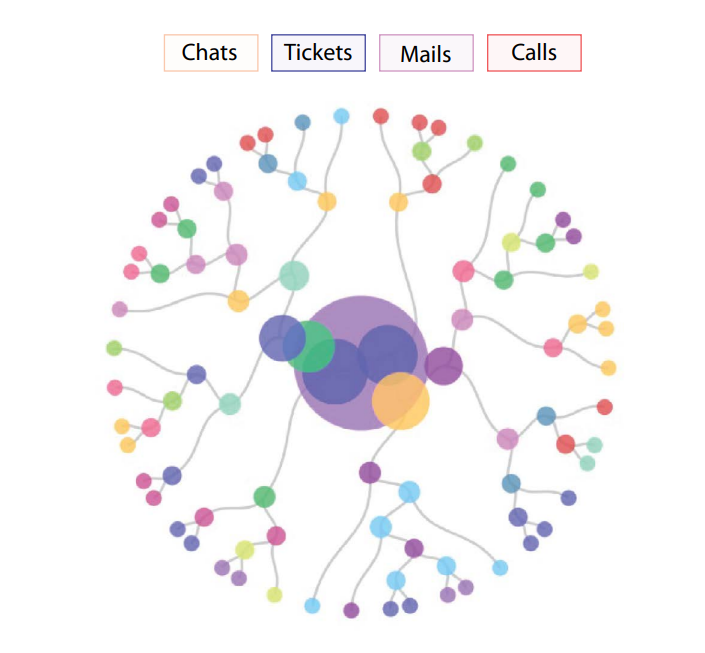Spend analytics
Traditional spend analytics tools can analyze data, provide spend visibility, and even uncover opportunities for better spend management. However, these tools deliver static insights based on pre-configured rules and simple simulations. The structured navigation of the solution requires the user to follow a predefined path to uncover specific details.
Gen AI is changing the game. It empowers procurement professionals to extract actionable insights from vast datasets, enabling informed decision-making and risk mitigation without navigating complex options.
Users can ask specific and complex questions, such as:
• “Identify the top 10 Asian suppliers (excluding China and India) with whom we spend over $10 million annually but lack a contract.”
• “Find the top 25 items in North America purchased at different prices from the same or different suppliers in the past year, along with the total spend on these items. Additionally, calculate the potential savings if these items were always purchased at the lowest price.”
These are just examples of how Gen AI allows for granular analysis of spend data. The application of Gen AI becomes even more interesting in opportunity identification. With a simple question like “what are the savings opportunities in the MRO category?”, Gen AI analyzes the data from multiple dimensions, evaluating supplier fragmentation, price variances, and non-contract/non-catalogue spending to uncover opportunities for better spend management.
Category management
Gen AI offers tremendous support to category managers in various aspects of their roles. Spend analytics and opportunity identification, as explained above, become significantly easier and more intuitive. Market Intelligence is another area undergoing a significant transformation. Gen AI eliminates the need to sift through voluminous reports, instead providing actionable insights and contextual information directly relevant to the category manager’s needs. Additionally, it seamlessly integrates internal data and external market insights, enabling data-driven decision-making.
Creating category playbooks and cards, traditionally a highly manual and time-consuming process, is another area where Gen AI offers immense benefit. A Gen AI module can continuously track content, buying patterns, supplier status, and other relevant data points. This allows it to automatically build and update playbooks, saving category managers hundreds of hours annually. While the module requires initial trainings and adjustments, it quickly becomes an independent assistant, streamlining workflows and boosting productivity.
Sourcing
Sourcing is a prime area where Gen AI can significantly impact every aspect. Document creation, a well-established use case of Gen AI, is highly relevant for crafting requests for proposals (RFPs). Gen AI efficiently handles tasks like building RFPs from scratch, comparing them to past examples and templates, and ensuring completeness. But its capabilities extend far beyond. Gen AI can provide real-time support to sourcing managers by managing supplier Q&A, generating comparative analyses, preparing scorecards, performing pricing simulations, and even facilitating negotiations.
Gen AI also simplifies the process for sourcing managers who often need to evaluate specific details. For instance, it can answer questions like “Which 3 suppliers best adhere to the provided contract template?” or “Which suppliers have proposed the most SLA deviations?” Furthermore, Gen AI offer significant relief for complex pricing evaluations, particularly in categories like construction with BOMs containing thousands of line items. It can answer complex pricing questions, such as how the comparison changes after removing outliers or which items exhibit the greatest price variance across suppliers.
For tail spend or spot buys, the Gen AI module can automate the entire process. The module can handle tasks like supplier longlisting, RFQ creation, sending requests to vendors, collecting responses, analyzing bids, conducting negotiations, selecting suppliers, and placing orders. Even in strategic sourcing, the module quickly learns to suggest supplier shortlists and highlight key techno-commercial negotiation points, facilitating final supplier selection.
Contracting
The traditional S2P process has always encountered a myriad of challenges, especially in contracting. However, Gen AI is set to revolutionize this area by impacting every step:
Authoring contracts: Similar to how Gen AI creates RFPs, it can efficiently draft contracts.
Managing revisions: Gen AI excels at managing revisions (redlining) during contract negotiations.
Identifying risks: Its powerful natural language processing (NLP) capabilities allow it to understand complex contract terms and identify potential risks within the contract, ensuring compliance and mitigating legal risks.
It can significantly streamline the typically time-consuming contract review process. Gen AI can answer questions like, “What are the key differences between this contract and our standard template?” or “What are the key risks identified in this contract?” Gen AI capabilities extends beyond individual contracts, allowing it to analyze your entire contract repository. For example, imagine asking, “Which supplier contracts have a limitation of liability exceeding $5 Mn for our company?” Or something as simple as, “Which contracts are up for renewal in the next 3 months and have been extended for the past 5 years?” The best part? Gen AI can navigate contracts in any format, structure, or even language.
Supplier management
Supplier management within S2P has struggled with implementing the right processes and technology solutions. It is a broad area, encompassing strategic components (supplier segmentation, supplier relationship management, supplier performance management, and supplier risk management) and tactical components (supplier onboarding and vendor master management). Efficiently managing each component requires a different strategy and process. Generative AI enables the creation of an automated eco-system to manage the various aspects of supplier management.
For instance, supplier performance management alone requires inputs from multiple sources in various formats. Certain objective elements of performance like on-time delivery and parts quality are extracted from the ERPs or S2P platforms. Contract data and QBR reports might provide SLA performance and ESG compliance information. Finally, user surveys might capture data on after-sales support and responsiveness.
Gen AI can structure this entire process, managing data collection at predefined intervals. It can then provide a live performance dashboard for all key suppliers. The same approach applies to ‘supplier risk management’ (SRM), where Gen AI can efficiently and dynamically gather data from various sources, creating a holistic risk profile for each supplier. Gen AI’s predictive analytics capabilities enable organizations to anticipate supplier behaviour and proactively address potential supply chain disruptions, making it a powerful tool for supply chain management.
Procurement
The downstream procurement value chain has been automated significantly over the years. Gen AI will augment it further, to make the interfaces more intuitive, improve accuracy, and significantly enhance overall user experience.
Guided buying, a feature existing in many buying platforms has seen significant effectiveness with the help of Gen AI. For instance, a user may try to create a purchase request for a laptop. With Gen AI, the system prompts and asks relevant questions such as preferred RAM and screen size, making the process easier.
Additionally, the system can share data on past laptop purchases, including supplier details and pricing. It can even recommend preferred suppliers and contracted models. Gen AI eliminates the need for users to navigate complex systems or possess detailed product knowledge. The system prompts for information and shares relevant details intelligently. With all this upfront guidance, users can make informed buying decisions, ensuring complete and compliant purchase requests, leading to a smoother overall process. Implementing Gen AI is particularly helpful for service buying, where it can create a complete SOW on behalf of the user, based on prompts and interactive Q&A.
 Gen AI is transforming Help desks across industries, including procurement. It can handle more than just resolving queries; it performs live issue analysis and root cause identification. Often, the root cause of a seemingly simple issue lies elsewhere. Gen AI can do this in real-time, saving time and manual effort. This application extends beyond the helpdesk to any process with bottlenecks, such as blocked invoices or delayed PR approvals.
Gen AI is transforming Help desks across industries, including procurement. It can handle more than just resolving queries; it performs live issue analysis and root cause identification. Often, the root cause of a seemingly simple issue lies elsewhere. Gen AI can do this in real-time, saving time and manual effort. This application extends beyond the helpdesk to any process with bottlenecks, such as blocked invoices or delayed PR approvals.
The initial user queries might include “Which supplier should I use?”, or “How can I find a detailed item description?”. Subsequent queries could be, “Is there a preferred supplier for this item?” or “How do I access a catalogue for this item?” Next layer could be “Why can I find the item searching manually in catalogues but not in guided buying?”
Eventually, it could be discovered that the root cause of all the queries is the fact that the relevant catalogue is not being recalled during guided buying due to some technical glitch. The Gen AI-based help-desk analytics will automatically find this correlation by analyzing all the relevant queries from different sources such as email, chat, tickets, or phone calls. The category manager can then fix the problem early on and all potential queries originating from the issue can be avoided"





